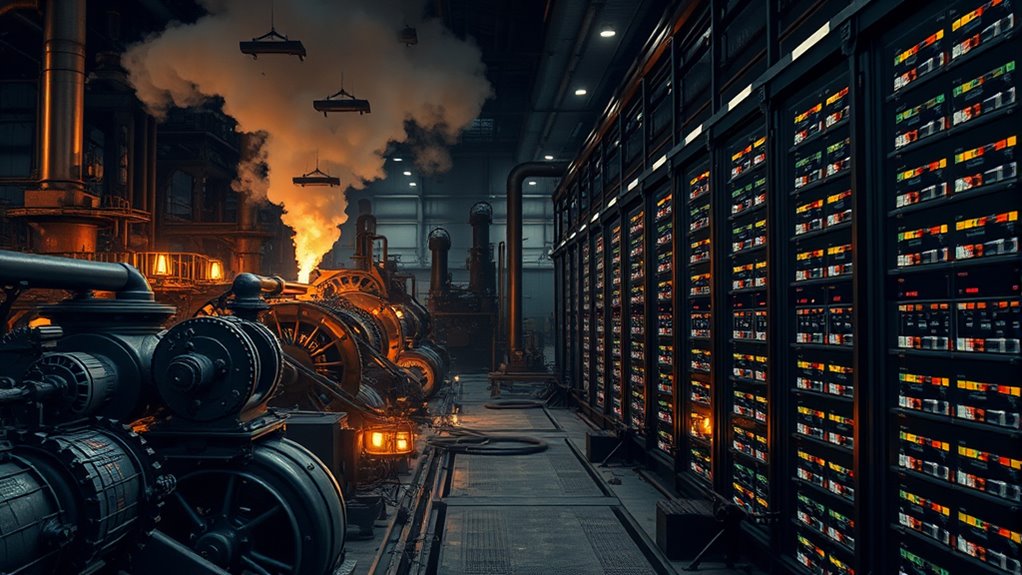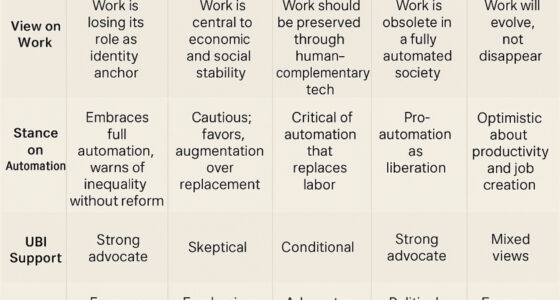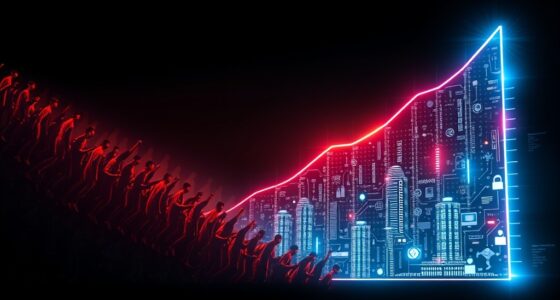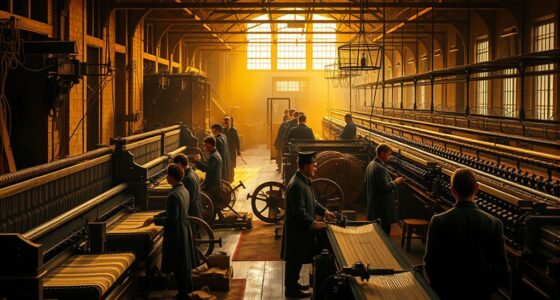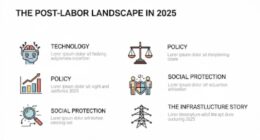The Industrial Revolution teaches you that technological change brings both opportunities and challenges. As innovations like the steam engine and railways transformed industries and urban life, they also caused job displacement and social shifts. To succeed in the AI era, you need to anticipate disruptions, invest in infrastructure and reskilling, and develop policies that promote fair growth. Understanding these past lessons helps you prepare for a smoother progression—if you keep exploring, you’ll uncover even more insights.
Key Takeaways
- Strategic government investments in infrastructure and innovation drove industrial growth, highlighting the importance of policy support for AI-driven economic shifts.
- Technological advances can displace workers but also create new job sectors, emphasizing the need for reskilling and workforce adaptability.
- Economic inequality may deepen during transformative eras, requiring policies that promote fair wealth distribution and social mobility.
- Urbanization and societal changes follow technological revolutions, necessitating infrastructure planning and social safety nets.
- Monitoring, compliance, and ethical considerations are crucial to ensure sustainable and inclusive growth during AI’s economic transition.
Technological Breakthroughs and Industry Transformation
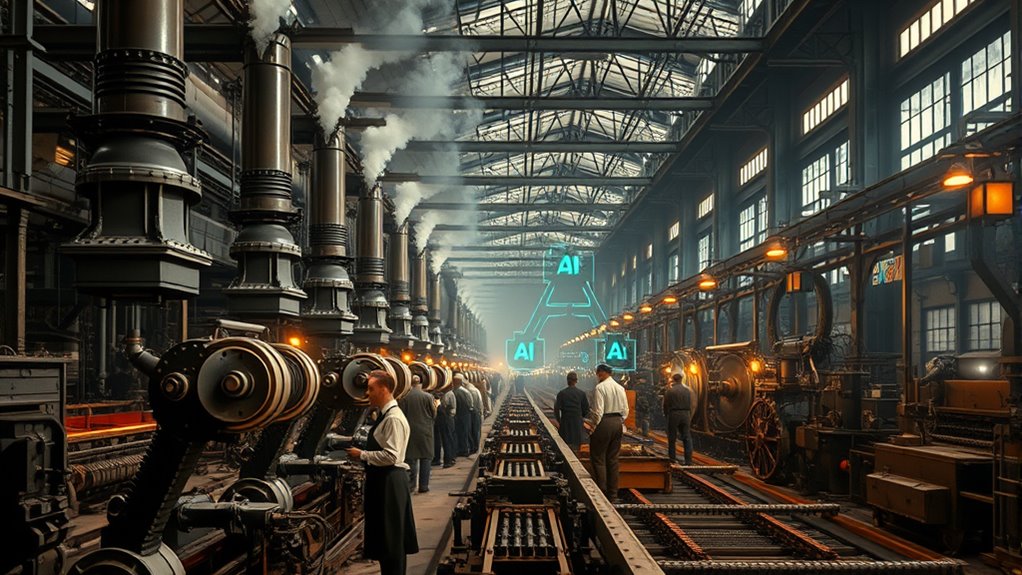
Have you ever wondered how technological breakthroughs have reshaped industries over time? The Industrial Revolution is packed with innovations that revolutionized how we produce goods. The Spinning Jenny, invented by James Hargreaves around 1764, allowed you to spin multiple threads at once, speeding up textile production. The steam engine, improved by James Watt in 1769, powered factories and trains, transforming transportation and manufacturing. Edmund Cartwright’s power loom made weaving faster and more efficient. Eli Whitney’s cotton gin in 1793 skyrocketed cotton output, fueling the textile industry. Later, the Bessemer process in 1856 enabled mass steel production, supporting large-scale construction and machinery. The development of the telegraph in the 1830s revolutionized communication across long distances, further transforming industries and society. These breakthroughs didn’t just improve efficiency—they transformed entire industries, shaping the economy and society in profound ways, with the rise of mass production techniques changing how goods were manufactured and consumed. Additionally, the adoption of electricity during this era further accelerated industrial growth and innovation.
Shifting Socioeconomic Structures and Class Dynamics
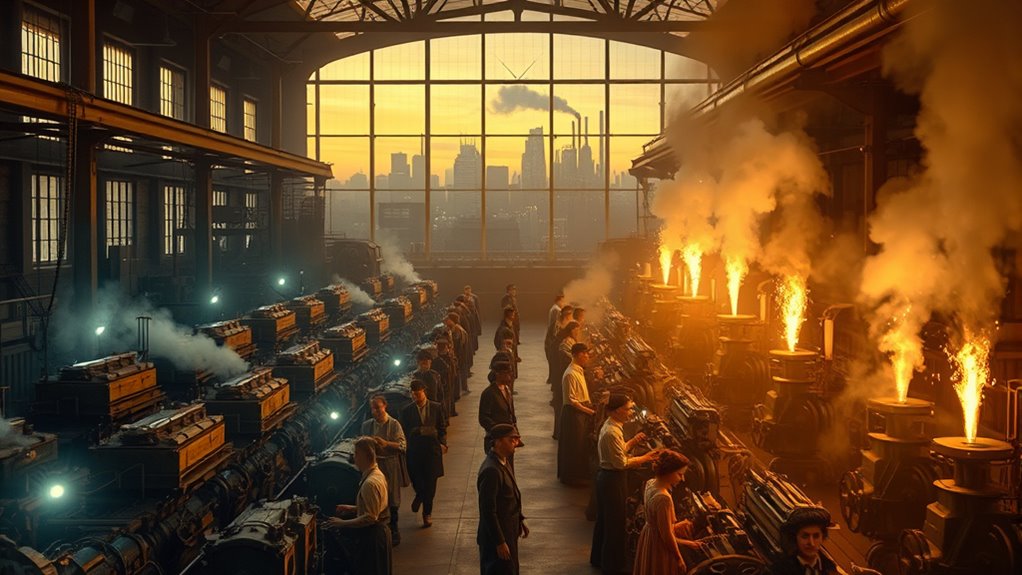
The Industrial Revolution fundamentally reshaped socioeconomic structures by redistributing wealth and creating new class dynamics. You experienced the rise of a wealthy class of industrialists, transforming traditional wealth sources and broadening economic opportunities. The middle class expanded as more people gained access to prosperity, while working conditions for laborers remained challenging. Key shifts included:
- Wealth distribution became more widespread but still highlighted disparities.
- Land’s dominance declined, replaced by industrial and capital-based wealth.
- Social stratification deepened, with new power and class distinctions emerging, influenced by evolving wealth distribution mechanisms. These changes contributed to the emergence of new social tensions as different groups navigated shifting economic realities.
- Additionally, technological innovations and the growth of cybersecurity measures have influenced modern economic stability and societal security. These shifts also prompted new legal and regulatory frameworks to address the changing economic landscape.
These changes altered societal roles, increased economic mobility for some, and introduced new social tensions. As wealth and class structures evolved, the fabric of society became more complex, setting the stage for ongoing social and economic debates.
Impact on Labor Markets and Urban Growth
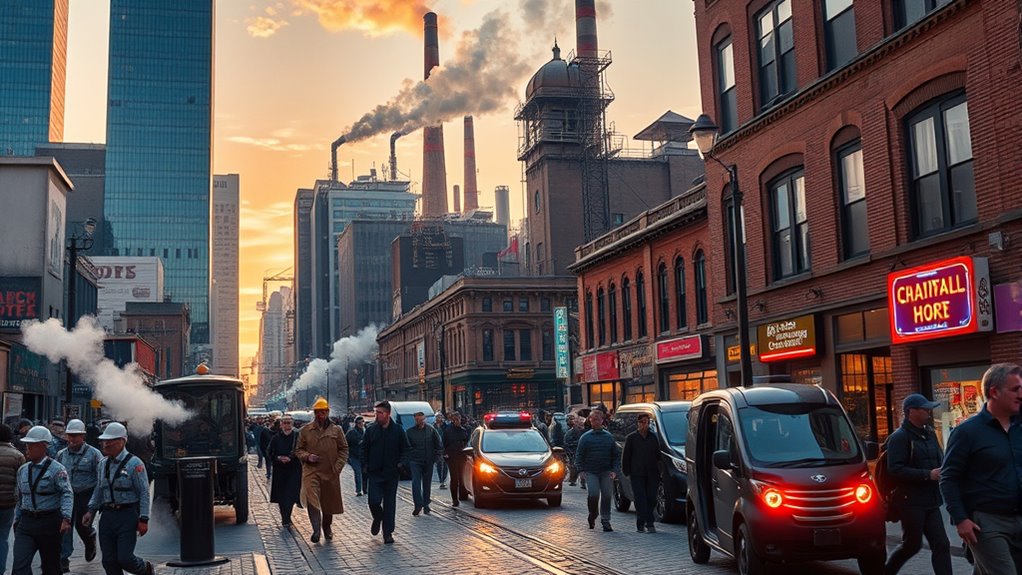
Industrialization dramatically transformed labor markets and urban landscapes by creating new employment opportunities while displacing certain jobs. You saw manufacturing jobs rise initially, then decline as service sectors grew, shifting worker skills toward more specialized roles. Productivity gains led to higher wages and new job types, but automation also posed risks, with nearly half of US jobs potentially vulnerable. Before the Industrial Revolution, 80-90% of the global population worked in agriculture. Urban growth accelerated as rural populations moved to cities seeking factory work, transforming urban infrastructure and lifestyles. Cities became economic centers, offering wealth beyond land, though overcrowding and poor conditions emerged as challenges. Wage structures changed, with income growth and new wealth avenues, yet disparities persisted. Technological advancements pushed workers to adapt continuously, fostering industry evolution and emphasizing the importance of skill diversification. Additionally, the rise of urbanization prompted significant changes in social and economic structures, influencing policies and community development. The development of electric power was crucial in powering factories and urban areas, accelerating industrial growth and urban expansion. Moreover, innovations in transportation infrastructure further facilitated the movement of goods and people, reinforcing urbanization and economic development. Furthermore, the increased demand for energy sources during industrialization led to significant developments in energy production, shaping modern power systems and resource management. The integration of labor regulations also played a vital role in improving working conditions and shaping industrial growth.
Policy and Infrastructure: Facilitators of Change
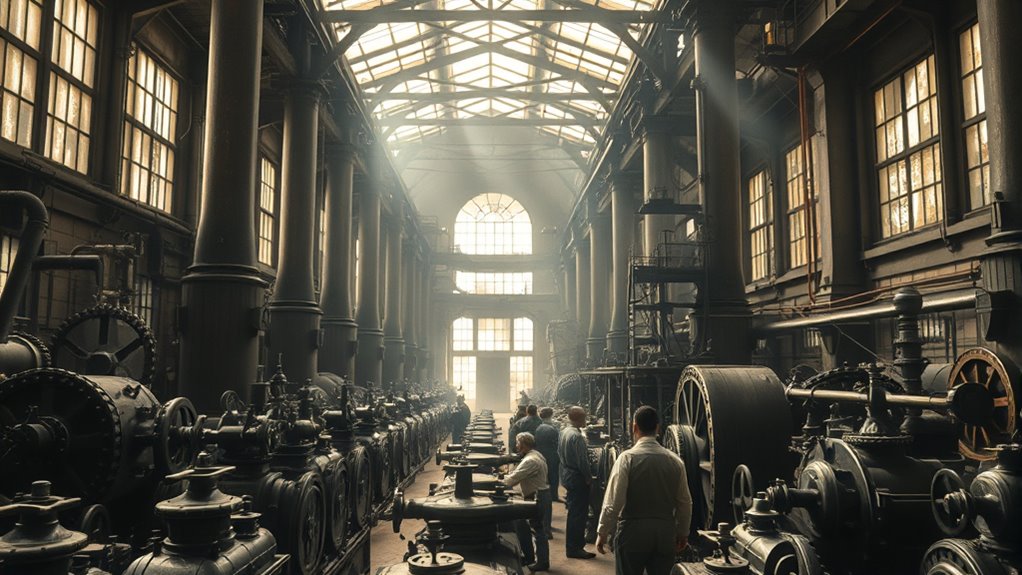
You play a key role in shaping economic change through policies that support infrastructure growth and trade. Government incentives and strategic expansion efforts can boost investment and regional development, while trade policies protect industries and facilitate markets. By aligning these elements, you help create a resilient foundation for ongoing economic progression. Incorporating high-quality projectors into public infrastructure can further enhance technological integration and economic resilience. Additionally, integrating emerging AI-driven tools into planning can optimize resource allocation and policy effectiveness. Recognizing the importance of consumer trends, such as the demand for innovative flavors and dairy-free options, can also inform better economic strategies and market development. Embracing creative practices within policy development can foster innovative solutions to complex economic challenges. Moreover, understanding the safety features of modern technological devices can improve public trust and encourage adoption of new innovations.
Government Incentives and Support
Government incentives and support have historically played a pivotal role in shaping economic shifts by providing the necessary policy frameworks and infrastructure. During the Industrial Revolution, policies like tariffs protected domestic industries, while grants and monopolies spurred innovation. Tax incentives encouraged investment in targeted sectors, and export promotion boosted growth. You also benefited from infrastructure investments such as railways, canals, and utilities that facilitated industrial expansion. These measures created a conducive environment for rapid development. Additionally, Gold IRA Rollovers served as a modern example of leveraging government-supported financial products to diversify and secure investments. Regular audits and metrics monitoring were essential during the Industrial Revolution to ensure compliance and track progress, similar to modern SQA Best Practices that help optimize processes and sustain growth. Furthermore, investments in infrastructure like utilities and transportation continue to be critical in supporting large-scale industrial initiatives today.
Infrastructure Expansion Strategies
Building on the support provided by government incentives, expanding and improving infrastructure became a key driver of economic change. You see, road networks near industrial regions and the southern coast improved through better engineering and investor confidence. Turnpike trusts managed critical roads, funding upgrades with toll revenue, while macadamized roads increased durability, facilitating faster land transport. These improvements boosted labor mobility, allowing workers to shift from transportation to manufacturing, fueling growth. Canal development enabled cheaper, long-distance bulk transport, linking manufacturing centers and lowering raw material costs—example being the 1761 Bridgewater Canal. Innovations in navigation and port infrastructure improved shipping speed and reliability. Urban infrastructure expanded rapidly to support growing populations and industries. Notably, the focus on infrastructure planning ensured these developments aligned with broader economic policies, catalyzing widespread industrial and urban growth. Furthermore, the establishment of standardized gauges and improved rail systems contributed significantly to the efficiency of goods movement, reflecting the importance of transportation infrastructure in industrial expansion. Additionally, the integration of professional services like mechanics and specialized cleaning services contributed to the efficiency and expansion of industrial activities. A key aspect of these developments was also the growth of vetted – Fin and Forage industries, which supplied essential materials and support services to sustain the expanding industrial base. Moreover, the adoption of emerging technologies in construction and transportation further accelerated infrastructure development and economic growth.
Trade Policies and Protections
Trade policies and protections during the Industrial Revolution played a crucial role in shaping economic growth by influencing how countries engaged with global markets. You’d see nations adopting tariffs and protectionist measures to shield emerging industries and secure trade advantages. Britain expanded its exports of textiles and manufactured goods, establishing a dominant global trade network centered around raw materials and finished products. Meanwhile, the U.S. used protective tariffs to nurture its nascent industries, shifting from trade deficits to surpluses over time.
- Protecting infant industries through tariffs increased domestic manufacturing.
- Britain’s focus on export-led growth expanded its industrial base.
- Lack of formal trade agreements led to bilateral and imperial trade reliance.
- The adoption of trade policies and infrastructure investments facilitated the expansion of international markets and economic resilience during this transformative period. These policies directly impacted economic development and international competitiveness during the era.
Challenges of Economic Displacement and Inequality
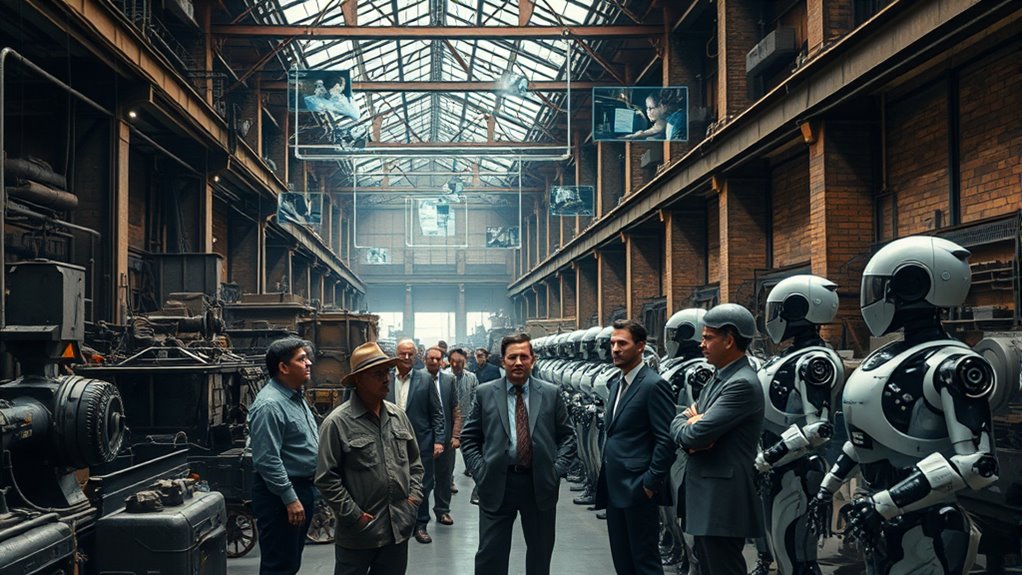
As economies shift due to technological advances, you’ll notice workers often face displacement and job insecurity, much like during past industrial changes. The wealth gap widens as benefits are unevenly distributed, leaving many behind while a few accumulate significant gains. This growing disparity can lead to social tensions and make it harder for displaced workers to find new opportunities.
Widening Wealth Gap
The widening wealth gap remains one of the most pressing challenges of modern economic transformation. Just like during the Industrial Revolution, wealth increasingly concentrates among a small elite, leaving many behind. You’ll see this in several ways:
- The top 10% globally control around 50-60% of income, while the bottom half only gets 5-15%
- Wealth accumulation favors industrialists and business owners, deepening social stratification
- Income disparities persist even as middle classes grow, often struggling to maintain status
Despite economic progress, the benefits aren’t shared equally. As technology advances, the rich get richer, and inequality deepens, posing serious risks for social stability and economic fairness.
Displaced Workforce Challenges
Displacement due to technological changes presents significant challenges for workers and economies alike. Throughout history, innovations like the Industrial Revolution caused widespread job loss, and today, the Fourth Industrial Revolution threatens to displace millions globally through AI and automation. You may find yourself shifting from skilled roles to lower-skilled jobs, often facing income reductions and job insecurity. Displacement frequently leads to higher unemployment and occupational downgrading, making it harder to maintain financial stability. Inequality worsens as displaced workers fall down the occupational skill ladder and earn less than their non-displaced counterparts. Access to education and social support varies, complicating adaptation efforts. To address these issues, governments must implement effective policies, invest in retraining, and strengthen social safety nets to help you navigate these ongoing economic shifts.
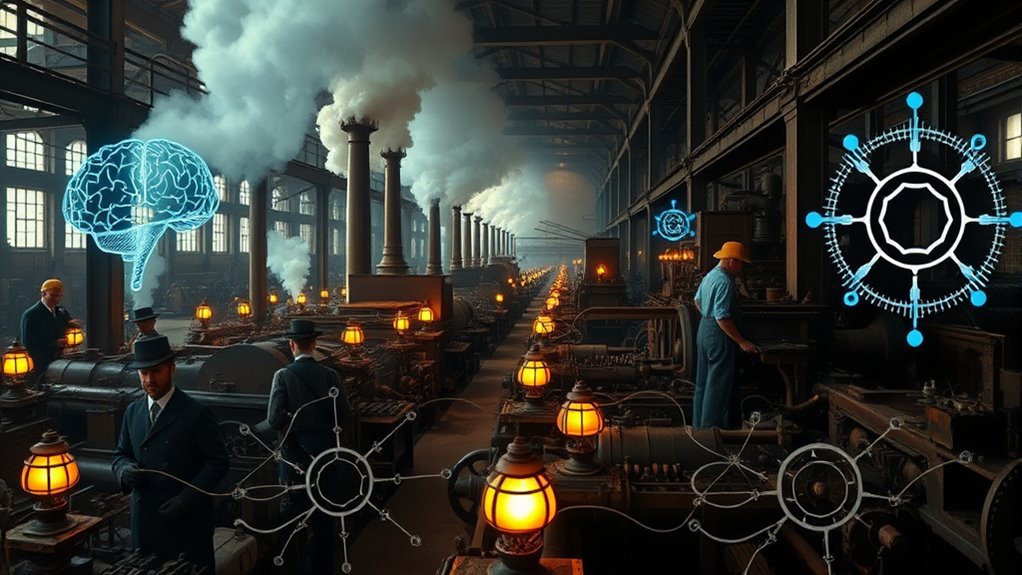
History shows that successful economic shifts require proactive adaptation and strategic planning. During the Industrial Revolution, societies that embraced technological change thrived, while those that resisted fell behind. To navigate future transitions, you need to focus on:
- Reskilling workers to match new job demands, much like industries shifted from traditional to machine-based methods.
- Investing in infrastructure that supports innovation, similar to railroads and bridges that expanded markets.
- Implementing policies that balance growth with societal needs, addressing urban overcrowding and inequality.
Frequently Asked Questions
How Did Societal Attitudes Change During the Industrial Revolution?
You see, during the Industrial Revolution, societal attitudes shifted substantially. People began valuing innovation and progress more than tradition, embracing change and new technologies. You might notice a growing focus on individual achievement and social mobility, even as class divisions persisted. Attitudes toward work also evolved, with many accepting factory jobs despite tough conditions, and there was a rising sense of optimism about economic growth and the future.
What Role Did Education Play in Supporting Industrial Workforce Shifts?
You see, education played a pivotal role in supporting shifts in the industrial workforce by providing specialized skills and practical training aligned with new technologies. It prepared you for assembly-line jobs, emphasizing efficiency, adaptability, and vocational training. As industries evolved, education expanded to include higher education and broader access, ensuring you had the knowledge needed to thrive in a changing economy and contributing to economic growth.
How Did Environmental Impacts Influence Industrial Development Policies?
You see, environmental impacts shaped industrial development policies by forcing governments to balance economic growth with ecological health. As pollution and resource depletion worsened, policymakers introduced regulations and pollution control measures, aiming to safeguard public health and the environment. Public activism and international cooperation pushed for stronger laws, while technological innovations aimed to reduce environmental damage. These efforts reflect a shift toward sustainable development, emphasizing that industry must grow responsibly to ensure future well-being.
Were There International Conflicts Related to Industrial Resource Competition?
You notice that international conflicts often stem from industrial resource competition. Countries fought over essential resources like coal, oil, and strategic territories, fueling tensions and wars. These disputes aimed to secure economic advantages and military strength. Today, resource competition still drives conflicts, such as in the South China Sea. Understanding this history helps you see that controlling resources has long shaped global stability and conflict, highlighting the importance of sustainable management.
How Did Consumer Behavior Evolve With Increased Industrial Production?
You’re riding a wave of change, as industrial production transforms your shopping habits. With more goods available and prices dropping, you become a savvy consumer, enthusiastic to buy new gadgets and luxuries thanks to mass production and technology. Market expansion and payment plans make it easier to indulge, fostering a culture of consumption. Your behavior shifts from necessity to desire, driven by innovation and the widespread availability of modern, affordable goods.
Conclusion
As you navigate new technological tides, remember history’s lessons of resilience and adaptation. Embrace change with courage, clarity, and caution, recognizing that progress propels prosperity but also prompts pitfalls. By balancing boldness with foresight, you can foster fairness and forge a future where innovation informs inclusion. Let’s learn from the past’s pitfalls and progress, ensuring that each shift transforms troubles into triumphs, turning challenges into chances for collective growth.
